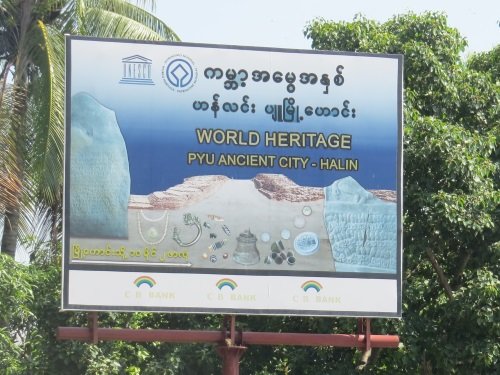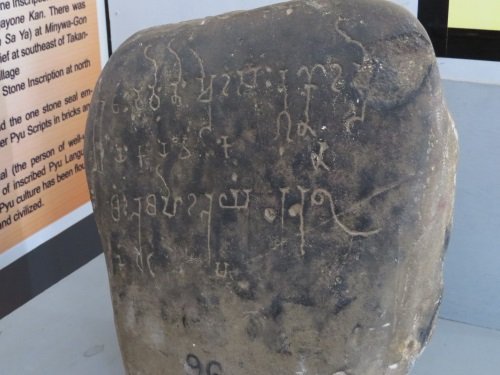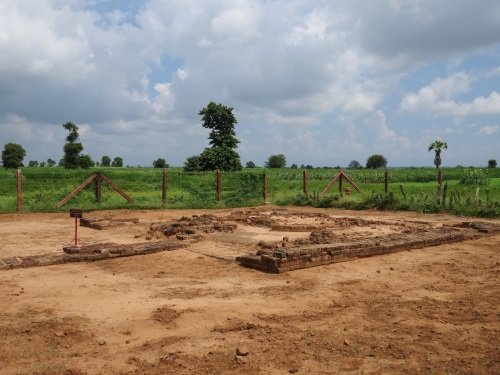Els Slots
WHS #587: Pyu City of Halin
Myanmar’s very first WHS came as a surprise in 2014: few will have visited one of the Pyu Ancient Cities before its inscription. History wise, it is not an illogical choice however. The Pyu were the first of the civilizations that settled along the Ayeyarwady River, in what is the heartland of current Myanmar. They started building city-states here from the 2nd century BC on. They came from the north (the Tibeto-Burman plateau or India) and brought Buddhism with them.

|
| I'm a sucker for these kind of signs |
None of the three Pyu cities Halin, Beikthano and Sri Ksetra lie close to the main tourist destinations in Myanmar. While I was staying in Mandalay, I hired a car plus driver and guide for the day and went for Halin. Though only 95 km, the trip took us 2.5 hours. We found our way out of the busy streets of Mandalay, and then passed the lovely Sagaing with its numerous gilded stupas. Afterwards it’s a long haul northwards in the direction of Shwebo. The guide had been there once before, but they do not make it out to Halin often. So driver and guide took some time asking around for the right turn-off. It turned out that there is a huge sign pointing to the World Heritage. From that sign it’s another 17 km on a semi-paved country road. We had to stop several times to let cattle and goats pass. Halin was and still is a major agricultural area, the land made fertile by irrigation. You’ll mostly see rice paddies (they export rice to China!), but also sesame is grown here.
Arriving at Halin and passing the hot springs in town we went straight for the Archaeological Museum. Here you have to pay the 5,000 kyat entrance fee (3,50 EUR). In return you get a ticket and even a folder in the English language. My name went into the visitor book, that showed that a number of people do visit each day – mostly from larger towns in the region such as Shwebo. The museum itself houses about 10 glass cases with objects found at Halin. A lot of pottery, but also series of decorated pipes and an ornamental candle holder with space for 4 candles. A stone slab shows inscriptions in Pyu writing , a script with elongated characters that is different from the contemporary Burmese.

|
| Stone slab with engravings in Pyu writing |
After the museum we went back into the car to start the circuit around the archaeological site. Because it stretches over several kilometers a car (or motorbike) is necessary. These are essentially still farmlands, and the Pyu findings have been singled out and are “protected” by circles of cacti. Like the other Pyu cities, Halin was surrounded by a city wall. Parts of it have been excavated, and also some of the entrance gates. The Eastern Gate was our first stop, two rows of bricks with a bend at the corners. The other remaining gates looked pretty similar. Traces of stupas or monasteries also have been found, their ground plans can still be distinguished. All single locations have a unique number, and boast an information panel with explanations in Burmese and English.
More spectacular findings are kept in a covered building. Both pottery and human skeletons are left in situ in the layers where they haven been discovered. A previous reviewer might be comforted in the fact that it’s not possible anymore to step into these graves and possibly damage the bones. Outside that building we found the one and only Halin souvenir hawker ! He even was selling Halin WHS T-shirts, quite a collectors item. We there also met with a government official who came after us and wanted our names & passport numbers. He apologized for the poor outfits of the staff (“we don’t even have uniforms”). A woman from the museum went ahead of us on her motorbike to the last 2 sites, ones that have to be opened up with a key. They are a collection of stone slabs, inscribed with mostly Burmese and some Pyu texts, and another graveyard. My guide said that despite Halin’s WH status, he does not think it will ever attract many tourists. He is probably right, low heaps of brick in farmland will get few people excited. There still is not much known about the Pyu, I believe that more research would make a better-selling story. Going out there to see how rural Myanmar lives I found certainly worth the trip. It reminded me of Mahansthangarh TWHS in Bangladesh.

|
| Foundations of a stupa |
Halin seems to be the least interesting of the 3 inscribed Pyu cities, with Sri Ksetra being the main site. ICOMOS could even not find enough justification for the inscription of Halin, while they saw sufficient in the other two cities. Their report on the three sites was pretty harsh in general, and Deferral was advised. They were especially reluctant of accepting the view that the Pyu cities had served as role models for Angkor. The ICOMOS advice was overturned during the disorderly 2014 WHC session where at some point each site got in no matter what the Advisory Bodies had suggested. So here we are with the three Pyu Ancient Cities, recognized for the spread of Buddhist urbanism across Southeast Asia, testimony to the past Pyu civilization and innovative urban planning.
More on
Els SlotsComments
No comments yet.
